Growing Demand for Energy Efficiency
The Global Adaptive Lighting System Market Industry is experiencing a surge in demand for energy-efficient solutions. As urbanization accelerates, cities are increasingly adopting adaptive lighting systems to reduce energy consumption and lower operational costs. These systems can adjust brightness based on real-time conditions, leading to significant energy savings. For instance, municipalities that have implemented adaptive lighting have reported reductions in energy use by up to 50 percent. With the market projected to reach 10.1 USD Billion in 2024, the push for sustainability and efficiency is likely to drive further investments in adaptive lighting technologies.
Government Initiatives and Regulations
Government policies and regulations are increasingly favoring the adoption of adaptive lighting systems within the Global Adaptive Lighting System Market Industry. Many countries are implementing energy efficiency standards and incentives for municipalities to upgrade their lighting infrastructure. For instance, initiatives aimed at reducing carbon emissions often include provisions for smart lighting solutions. These regulations not only promote sustainability but also encourage local governments to invest in adaptive lighting technologies. As a result, the market is anticipated to expand, potentially reaching 20.1 USD Billion by 2035, as more jurisdictions recognize the benefits of modern lighting systems.
Increased Focus on Smart City Initiatives
The Global Adaptive Lighting System Market Industry is benefiting from the global trend towards smart city initiatives. Cities worldwide are investing in smart technologies to enhance urban living, and adaptive lighting is a key component of these efforts. By integrating adaptive lighting systems into smart city frameworks, municipalities can optimize energy use, improve safety, and enhance the overall urban experience. For example, cities that have adopted smart lighting solutions report improved traffic management and reduced crime rates. This growing focus on smart city development is expected to drive the market forward, as more cities recognize the advantages of adaptive lighting.
Technological Advancements in Lighting Solutions
Technological innovation plays a crucial role in the Global Adaptive Lighting System Market Industry. The integration of Internet of Things (IoT) and smart sensors into lighting systems enhances their functionality and adaptability. These advancements allow for real-time monitoring and control, enabling systems to respond dynamically to environmental changes. For example, smart streetlights can adjust their brightness based on pedestrian presence or ambient light levels. As these technologies become more prevalent, the market is expected to grow significantly, with a projected CAGR of 6.48% from 2025 to 2035, indicating a robust future for adaptive lighting solutions.
Rising Urbanization and Infrastructure Development
The rapid pace of urbanization is a significant driver for the Global Adaptive Lighting System Market Industry. As cities expand, there is an increasing need for efficient and effective lighting solutions to accommodate growing populations. Adaptive lighting systems can enhance public safety and improve the quality of life in urban areas by providing better illumination where it is needed most. Moreover, infrastructure development projects often incorporate smart lighting solutions to ensure sustainability and energy efficiency. This trend is likely to contribute to the market's growth, as urban planners and developers seek innovative solutions to meet the demands of modern cities.
























Leave a Comment